[7주차] LPCNET: IMPROVING NEURAL SPEECH SYNTHESIS THROUGH LINEAR PREDICTION
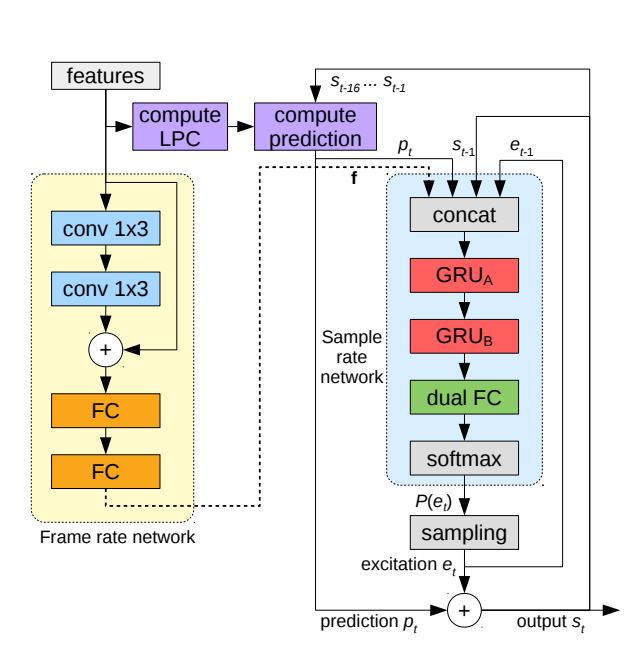
작성자 : 권오현
Abstract
Neural Speech Synthesis 모델들은 Text-to-Speech 와 compression applications을 위한 high quality 읍성 합성이 가능한 것을 입증했다. 이러한 새로운 모델들은 real-time operation을 위해 powerful GPUs가 필요한데, WaveRNN을 변형하여 Linear Prediction과 recurrent neural networks를 결합한 LPCNet을 제안함으로써 WaveRNN보다 훨씬 더 높은 퀄리티의 Speech synthesis가 가능하며, 3GFLOPS보다 낮은 complexity로 embedded systems나 mobile phones와 같이 lower-power devices에 deploy할 수 있음
FLOPS : 초당 부동소수점 연산, 컴퓨터가 1초동안 수행할 수 있는 부동소수점 연산의 횟수를 기준으로 삼는다.
ex) GPT-3의 사전 학습에 필요한 계산은 3640 petaflop/s-day ( 24시간동안 초당 (1000조)개의 부동소수점 연산을 수행하는데 소요되는 전력
Introduction
-
Neural Speech synthesis 모델은 최근에 high-quality speech synthesize와 code high quality speech at very low bitrate
-
WaveNet 기반의 알고리즘들은 high-end GPU를 통해서만 real-time operation이 가능하기 때문에 end-user devices( ex. mobile phones)에서 사용불가
논문 저자들은 speech synthesis를 end-user devices에서 사용할 수 있게 하고자 함 (No powerful GPUs, Limited battery capacity)
-
FFTNET, WaveRNN 같은 모델들은 speech synthesis의 complexity를 줄이기 위해 노력함
-
Low bitrate vocoders와 같은 Low complexity parametric synthesis models이 존재함
- quality가 제한적이며, Linear Prediction을 사용하여 음성의 spectral envelope(vocal tract response)를 모델링 하는데 효율적이지만 excitation signal을 모델링 하는데 문제가 있음
Spectral envelope : 스펙트럼 포락선, 발음마다 vocal tract의 구조가 달라 주파수의 증폭과 감쇠가 달라짐, 발음의 종류를 결정하는 주요한 특징
excitation signal : 여기 신호, 유성음(여러 배음들로 스펙트럼 구성), 무성음(백색소음과 같은 스펙트럼)
- quality가 제한적이며, Linear Prediction을 사용하여 음성의 spectral envelope(vocal tract response)를 모델링 하는데 효율적이지만 excitation signal을 모델링 하는데 문제가 있음
저자들은 spectral envelope modeling을 neural synthesis network를 사용하지 않은 model을 제안하여 complexity를 줄이면서 SOTA모델과 동일한 quality를 보장하는 방법을 제안하였다.
WaveRNN
-
WaveRNN은 이전 Audio Sample인 과 conditioning parameters 를 통해 discrete probability distribution인 Output Sample 를 생성함
-
RNN(GRU) + Two fully-connected layers이 연결된 dual softmax layers로 구성되어 있으며, WaveNet과 비교하여 학습된 모델 사이즈가 작으며 speech synthesis가 빠름
- 16-bit model(8 coarse bits(=high bits) and 8 fine bits(=low bits)) 8 corarse bits를 먼저 예측하고, 이를 기반으로 8 fine bits를 예측하여, 16-bits sample을 예측하는 것이 아닌 8-bits sample을 두개 예측하여 complexity가 낮음
LPCNet의 경우 coarse/fine split을 생략
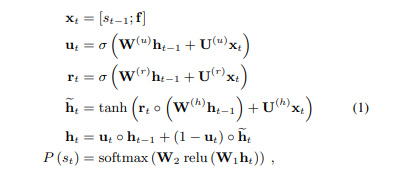
- 는 GRU weights, complexity를 줄이기 위해 GRU weights matrix를 4x4 or 16x1 non-zero block을 사용하여 spase하게 구성했음
LPCNet
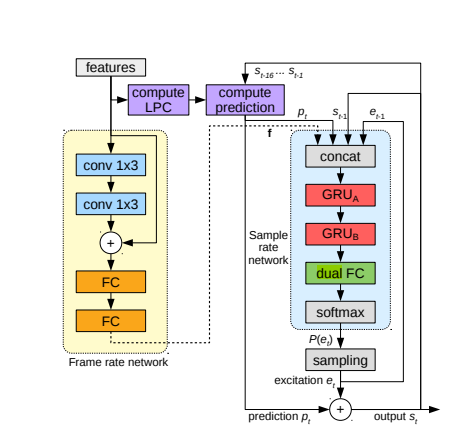
-
16kHz을 연산하는 sample rate network와 10-ms frames(160개의 sample, =100FPS)을 처리하는 frame rate network로 구성되어 있다
-
논문에서는 Audio input을 20 features로 제안하여 연구를 진행하엿다
- 18 Bark-scale cepstral coefficients, 2 pitch parameters(period, correlation)
Conditioning Parameters
- Frame rate network에서 Audio의 20features가 two convolution layers(filter size =3, conv 3x1)을 통해 5 frame의 receptive field가 되어 residual connection과 two fully-connected layers를 통과하여 128-dimensional conditioning vector 가 되어 sample rate networks의 conditioning vector 가 된다
Pre-emphasis and Quantization
-
WaveNet과 같은 synthesis model은 output sample values를 256으로 줄이기 위해 8-bit -law quantization을 사용한다
-
Speech signals의 대부분은 low frequencies에 집중되는 경향이 있기 때문에, -law white quantization noise는 high frequencies에서 들을 수 있다
이러한 문제를 해결하기 위해 16bits로 quantization (ex. Audio CD)을 하는 경우가 많다 -
위의 문제를 해결하기 위해 논문 저자들은 first-order pre-emphasis filter를 training data에 적용하였다
- pre-emphasis filter : , high frequencies에 대한 noise의 영향을 줄이기 위해 frequencies를 강화시켜 high frequencies의 noise 영향을 줄이는 방법
synthesis의 output에 대해서는 inverse(de-emphasis) filter를 적용하여 noise를 줄일 수 있었으며, 8-bit -law output이 high-quality synthesis에 성공할 수 있도록 만든다
- pre-emphasis filter : , high frequencies에 대한 noise의 영향을 줄이기 위해 frequencies를 강화시켜 high frequencies의 noise 영향을 줄이는 방법
Linear Prediction
-
Neural speech synthesis approaches는 glottal pulses, noise excitation, vocal tract response를 포함한 speech production process를 modeling 해야 한다
-
vocal tract response의 경우 all-pole linear filter를 통해 표현될 수 있다 (all-pole = autoregressive, AR, 자기회귀)
-
vocal tract를 필터로 본다면 필터의 coefficients를 구할 수 있으며, 이를 음성의 특징을 짓는 시스템으로 생각할 수 있다
-
를 time t의 signal로 생각하면, 이것의 linear prediction을 이전 샘플들을 기반으로 보았을 때 다음과 같이 생각할 수 있다

-
는 현재 frame을 위한 order linear prediction coefficients (LPC)로 볼 수 있다
-
를 구하는 방법 :

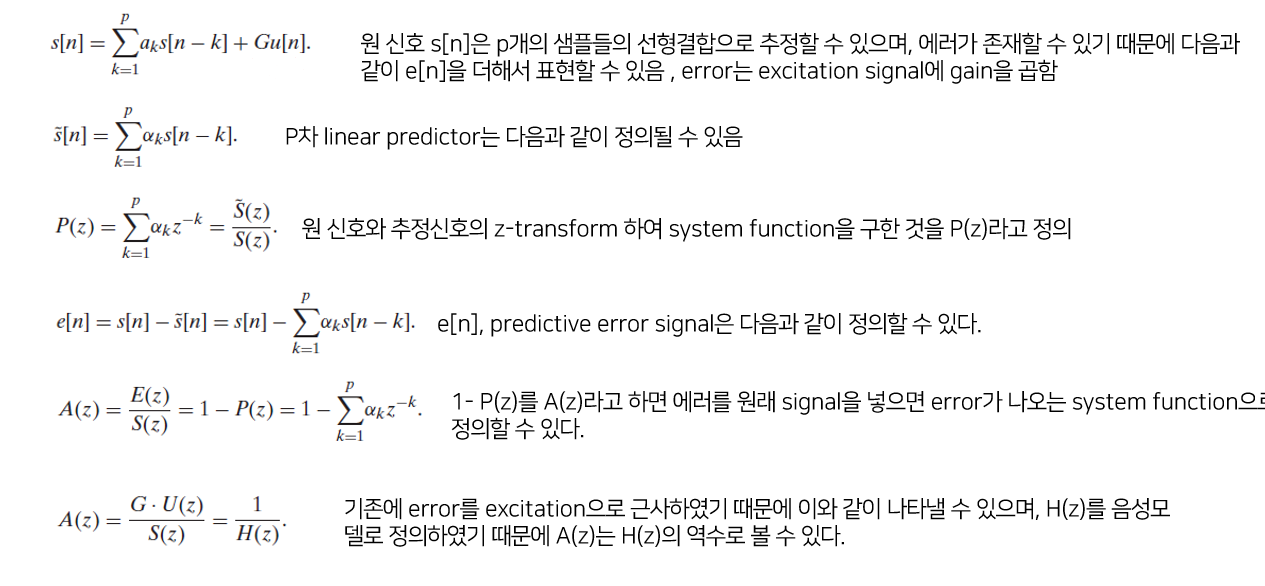
-
위의 식을 정리해보면 음성신호가 prediction error filter A(z)를 통과하면 excitation을 추정하는 error signal이 나오게 되며, 이러한 error signal이 vocal tract response model H(z)를 통과하면 음성신호가 된다

-
이러한 모델의 장점은 vocal tract를 all-pole model 식으로 하여 LP coefficient를 찾으면 되는 장점이 있음 -> 사이의 제곱으로 error function으로 정하여 최소화 하는 를 찾으면 된다

-
위의 식을 미분하면 다음과 같이 나온다

-
all-pole model이기 때문에 correlation으로 정리하여 matrix로 표현하면 다음과 같이 구할 수 있으며 쉽게 를 구할 수 있다
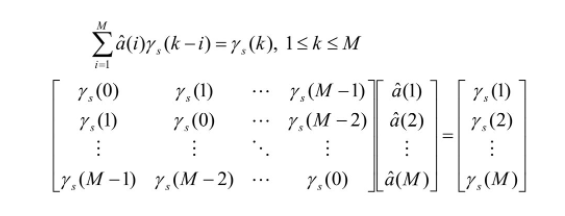
-
-
Prediction coefficients 를 계산하기 위해 18-band Bark-frequency ceptrum을 linear-frequency power spectral density(PSD)로 변환하여 계산해야 한다
- PSD는 Inverse FFT를 사용하여 auto-correlation으로 표현할 수 있으며 Levinson-Durbin algorithms을 통해 쉽게 Predictor의 coefficients 를 구할 수 있다.
-
Cepstrum으로 부터 구해진 Predictor는 speech coding text와 같은 additional information 또는 synthesize가 필요하지 않는다.
-
LPC Analysis는 cepstrum이 low resolution하기 때문에 input signal 만큼 정확하지는 않지만, network가 이러한 부분까지 학습할 수 있기 때문에 출력에 미치는 영향이 적다.
- WaveNet을 이용하여 vocal tract를 모델링 하려고 한 GlotNet의 open-loop filtering approaches보다 장점이 있다고 하였다.
-
Linear Prediction을 사용하여 neural network에 영향을 주어, network가 sample values를 예측하는 것이 아닌 excitation (prediction residual)을 예측하도록 도울 수 있다.
- 이는 network가 더 쉽게 예측을 할 수 있으며, 일반적으로 excitation이 pre-emphasized signal보다 작은 amplitude를 가지기 때문에 -law quantization noise를 감소시킬 수 있다.
-
즉, network 이전에 sampling된 excitation 뿐만 아니라 과거 신호 , current prediction 를 input으로 받아 더 좋은 성능을 낼 수 있다.
Output Layer
- Output Probabilities를 계산을 쉽게 하기 위해 two fully-connected layers을 경합한 dual_fc layers를 정의하였다. (element-wise weighted sum)

- dual fully-connected layer는 필수적인 요소는 아니지만 동일한 복잡도의 fully-connected layer와 비교 했을 때, output의 quality를 향상시킨다는 것을 발견했습니다.
Sparse Matrices
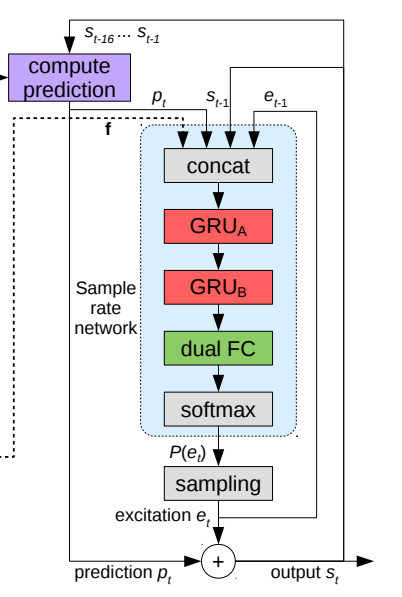
-
모델의 complexity를 낮추기 위해 저자들은 Largest GRU를 위해 일반적인 GRU(element-by-element sparseness) 대신에 WaveRNN에서 사용한 Block-sparse matrices를 사용하였다.
-
Training은 dense matrices로 시작하지만, 원하는 sparseness가 달성될때까지 magnitude가 가장 낮은 block을 0으로 만들어 vectorlization을 쉽게 하도록 하였다. (16x1 blocks가 우수한 성능을 제공하였다.)
Embedding and Algebraic Simplifications
-
일반적으로 sample values를 network의 input으로 하기전에 고정된 범위로 scaling을 하지만 논문 저자들은 -law values의 discrete한 특성을 통해 embedding matrix E를 학습하여 embedding을 하였다.
- Embedding은 각각의 -law level을 vector에 매핑하여, -law value에 적용될 non-linear function set을 학습한다. 그결과 embedding matrix를 시각화 하였을때, embedding matrix E -law scale을 linear하게 변환하는것을 알게 되었다.
-
sample values를 embedding한 값들을 GRU의 input으로 넣지 않고 GRU의 non-recurrent weights 의 submatrices와 pre-computing 하여 complexity를 감소하였다 .
-
를 sample 의 입력 sample의 embedding에 적용되는 columns로 구성된 의 submatrix라고 하면, sample 을 update gate의 non recurrent 항에 직접 매핑하는 새로운 embedding matrix = 로 표현할 수 있다.
-
모든 게이트 및 모든 입력 에 대해 pre-computed된 로 표현할 수 있다.
-
frame conditioning vector 또한 input의 entire frame에 대해 일정하기 때문에 위와 같은 방법으로 단순화 할 수 있다.
이러한 단순화를 통해 GRU의 모든 non-recurrent inputs의 cost를 무시하여 complexity를 낮출 수 있다.
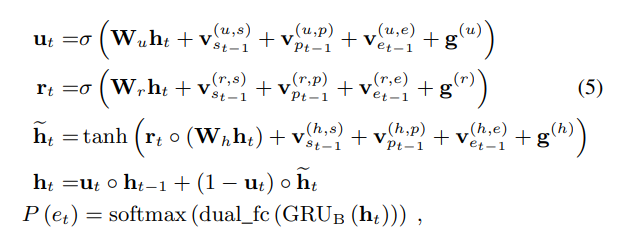
-
Sampling from Probability Distribution
-
Output Probability distribution 에서 직접 sampling을 하게 되면 excessive noise가 발생할 수 있다. 이것은 FFTNET 제안한 방법으로 상수 를 곱하여 해결할수 있지만, 논문 저자들은 이러한 binary voicing decision을 만드는 대신에 를 제안하여 문제를 해결하였다. ( : pitch correlation)
-
위의 방법을 통해 Probability distribution를 다음과 같이 정의하였다.

- operator는 분포들을 다시 정규화
-
논문 저자들은 일때 impulse noise을 줄이는것과 speech가 자연스러움의 trade-off중 좋은 성능을 보인다고 하였다.
Training Noise Injection
-
Speech를 synthesizing 할때, Network는 생성된 샘플이 훈련 중 사용된 샘플과 다르므로 불완전하다.
-
이러한 mismatch는 synthesis에서 excessive distortion을 야기할 수 있어 mismatch에 robust하게 만들기 위해 noise를 input에 추가하여 학습을 진행했다.
-
Linear Prediction을 사용하면 noise-injection이 중요한데, signal에 noise를 추가하여 학습을 하면 noise가 synthesis filter 와 같은 형태를 갖는 pre-analysis-by-synthesis vocoder era와 유사한 artifacts를 생성하는것을 확인하였다.
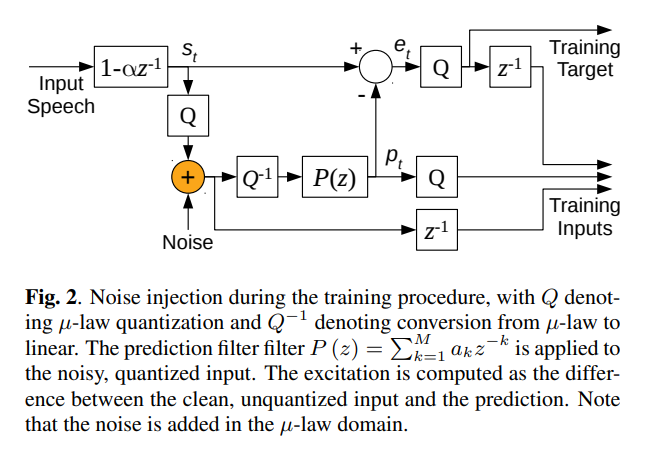
-
noise를 추가함으로써 network가 signal domain의 error를 최소화하는 것을 효과적으로 학습하는것을 확인했다.
network의 output은 prediction residual 이지만 input중 하나는 residual을 계산하는데 사용된 것과 동일하게 예측하기 때문에, CELP에서 제시한 analysis-by-synthesis 효과와 유사하며, synthesized speech의 artifacts를 크게 감소 시킨다. -
noise를 설정할 때, signal amplitude에 비례하도록 하기 위해 -law domain에 직접 추가하였으며, 범위의 uniform distribution으로 설정하였다.
EVALUATION
Complexity
-
LPCNet의 complexity는 two GRUs와 dual fully-connected layer로 이루어져있다.

-
: GRUs의 size, : density of the sparse GRU, : number of -law level, ; sampling rate
-
로 설정했을때 약 2.8GFLOPS의 complexity를 가짐( biases, conditioning network, activation-function, 는 약 0.5GFLOPS의 complexity)
-
그 결과 Apple A8(Iphone 6)의 single core로 real-time synthesis를 가능하게 함 (Iphone 6S정도 되야 잘된다고 하네요..)
-
WaveNet보다 작은 complexity를 가진다고 한 FFTNET의 경우 약 16GFLOPS, WaveRNN의 경우 10GFLOPS, SampleRNN의 경우 50GFLOPS complexity를 가진다고 한다
Experimental Setup
-
speaker-depedent or speaker-independent 중 더 어려웅 speaker-independent에서 평가를 하였다.
-
Training data는 NTT Multi-Lingual Speech Database for Telephonometry (21 languages)의 4시간 speech로 이루어져 있다.
-
120 - epochs, 64 - batch size, 각각의 sequence는 15 10-ms frames로 구성되어 있다.
-
AMSGrad optimization, step_size = , =0.001, = 5x, = batch number
-
의 size 192, 384, 640 non-zero density (GRUs의 size 61,122,203이랑 동일), 의 size 16으로 하여 LPCNet과 WaveRNN+와 비교하였다.
Quality Evaluation
-
subjective listening test인 MUSHRA를 통해 성능 비교를 하였다. (8 utterances , 2 male and 2 females speakers에 대해 100명에 의해 평가되었다.)
-
LPCNet이 WaveRNN+보다 좋은 Quality를 내는것을 확인했다. 이를 통해 pre-emphasis가 -law quantization의 noise를 무시할 수 있고, 256-value distribution(8-bit)으로 계산할 수 있기 때문에 16-bit의 WaveRNN보다 complexity가 감소한다
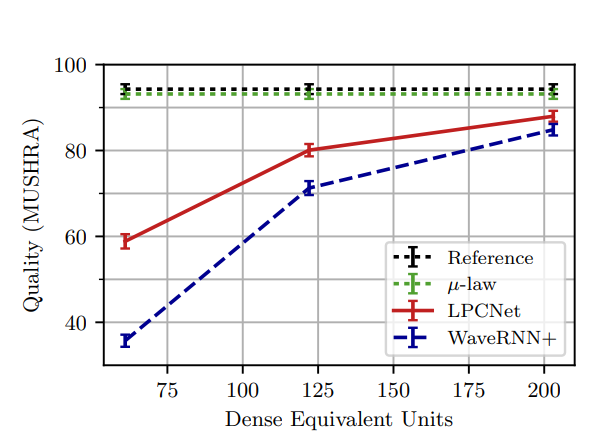
Conclusion
-
LPCNet은 neural synthesis techniques와 traditional technique인 linear prediction을 결합하여 speaker-independent speech synthesis 성능이 좋은것을 확인했다.
-
WaveRNN과 LPC를 단순히 결합하는거 외에도 signal values embedding, pre-emphasis와 같은 다양한 방법이 synthesis에 영향을 준다는 것을 알게 되었다.
2개의 댓글
[15기 황보진경]
본 논문은 Linear Prediction과 RNN을 결합하여 음성을 합성하는 방법론에 대해 설명하고 있다. 기존의 음성 합성은 Wavenet을 기반으로 이뤄지기 때문에 합성 속도가 느려 실제로 사용되기에는 무리가 있다. 이를 개선하기 위해 본 논문에서는 LPC에 NN을 결합하는 방법을 제안하였다.
WaveRNN은 AR 형태로 GRU와 두개의 fully-connected layer로 구성되어 있다. LPC net은 frame rate network와 sample rate network로 이뤄져 있다.
- Frame rate network에서는 18 bark-scale ce-steal coefficient와 2 pitch parameters가 인풋으로 들어가서 두 개의 convolution layer를 거쳐 conditioning vector f가 된다.
- Pre-emphasis and Quantization: frequency를 강화시켜 high frequency noise를 줄이고자 하였다.
- Linear Prediction: 전통적인 LPC 기법을 사용하여 prediction coefficient를 계산한다. 그리고 Network를 이용하여 noise 부분을 예측한다. 여기서 GRU의 복잡도를 줄이기 위해 WaveRNN에서 사용한 Block-sparse matrices를 사용하였다.


[15기 안민준]
1. LPCNet 에서의 Linear Prediction 은 결국 correlation 계산에 있어서 선형적인 연산이 들어가기 때문\ Autoregressive 한 연산이 선형적이기 때문으로 이해가 되는데, 혹시 어떤 것이 맞을까요?
2. excitation 을 추정한 뒤 vocal tract response model으로 음성을 예측한다고 작성했는데, 본문에서 vocal tract response model 이 구체적으로 어떤 부분인지 설명이 가능할까요? 잘 이해되지 못한 것 같습니다.